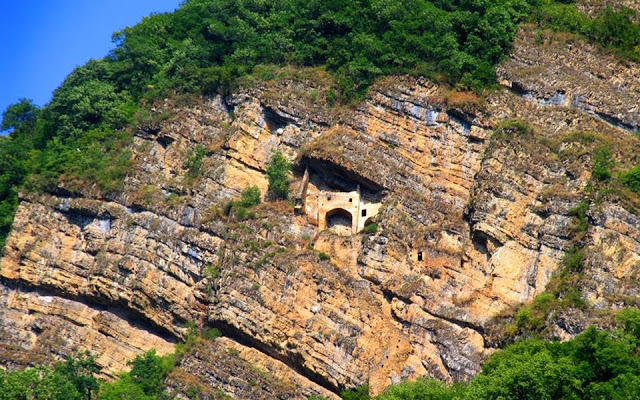This is a random thing I ran across while I was doing some research, and while it isn't something that will likely inspire anything in any books I'm writing right now, it feels like it might be inspirational for other authors out there, so I'm going to write a bit up about this place and what I've learned.
Perigala, literally "Fairy Castle" is located in a remote region of Azerbaijan, in the Caucasus Mountains, somewhere in the northern reaches of the country (the blue dot on the map below).
Due to the fact Azerbaijan has an underdeveloped tourism industry, and the fact that this place is so remote, it's one of those historical mysteries that has been nearly untouched by time. Carved into the side of a limestone cliff, is a castle. In an article published by Azerbaijan International in 2005, the last known person who managed to climb up the steep embankment to the castle itself was a man named Mammad Darudov, a local to the area, in the 1970s. There have been numerous attempts since, but none successful.
There have been attempts to make the climb easier, with stairs, and ladder and the like, but possibly earthquakes damaged the stairs, and even with the ladder, the climb is nearly impossible. Even with modern climbing equipment, apparently the mountain continuously defeats those who try to make the climb.
According to Oddity Central, "Parigala sits at the top of an enclosed stairway built of rough limestone bricks, cemented together with a very strong mortar that adheres to the mountain itself. The top of the stairway has apparently collapsed, with makes reaching the castle even more dangerous than before. According to journalist Ronnie Gallagher, climbing past this point is not for the faint-hearted as it requires incredible agility and mountaineering skills."
So, what is this place?
No one really knows. As you can see, it is extremely inaccessible, which likely means that whoever built it had a purpose to protect something, and with an aim for privacy in mind. An army coming from below would find the cliffside unscalable, and an army from above would likewise have similar issues. The most common guess I've found as to its construction is a theory that it was built during the Albanian Cacasian period, between the 4th and 8th centuries.
There is a main room and then three other smaller rooms in the palace proper, each with its own window, which you can see in the image below. Then, according to Mammad, there is another structure connected to the palace by walled walkways, that has two rooms.
Local lore about this place dates back to the days of Genghis Khan. The story says, that when Genghis Khan was marching through the area, he took a liking to the local ruler's daughter, and decided to take her as a wife. When he asked her if there was any other woman more beautiful than she, the young woman (or girl, depending on the story) told him of her sister, Peri.
Peri did not like this one bit, so as soon as she heard she was being added to Genghis Kahn's harem, she hired some workmen to build her a castle high in the cliffs, where she sought safety. However, the army came and set up camp at the base of the cliff. Knowing her capture was imminent, Peri fell to her death rather than turning herself over to Genghis Kahn.
Who knows how much (if any) truth there is to that myth, but it is all the information locals have on Perigala.





Comments
Post a Comment